BATTERIES FOR EMERGENCY LIGHT
All emergency lights and lighted emergency exit signs use a battery for powering the lamps. In order to insure continuous readiness and operation of the emergency light, these batteries are rechargeable. Circuitry within the emergency light both charges the battery and insures that it stays charged.
TYPES OF BATTERIES USED IN EMERGENCY LIGHTS
There are two types of batteries that are used for emergency lights; they are:
- Sealed lead-acid batteries (the same type used in cars)
- Nickel-cadmium batteries
Sealed lead-acid batteries are the oldest rechargeable technology available. They are called lead-acid because they contain lead alloy plates, immersed in acid. The acid breaks down the plates, producing the charged electrons which are electricity. More recently, technology of lead-acid batteries has improved, allowing for fully sealed units, that don’t require the addition of water to maintain the acid level.
VIEW OUR SELECTION OF EMERGENCY LIGHT BATTERIES
Nickel-cadmium batteries were the first ever “dry” (no acid required) rechargeable batteries. Since then, other technologies have been developed, but they are generally more costly. In a nickel-cadmium battery, the two metals are separated by a dielectric (non-conductive) layer, causing the metals to magnetically react with each other, producing the charged electrons that form electricity.
WHICH IS BETTER?
There are advantages and disadvantages of both types of rechargeable batteries used in emergency lighting fixtures.
|
Advantages of lead-acid batteries:
|
Disadvantages of lead-acid batteries:
|
|
Advantages of nickel-cadmium batteries:
|
Disadvantages of nickel-cadmium batteries:
|
Typically, lead-acid batteries are used in steel enclosure emergency lights and nickel-cadmium batteries are used in thermoplastic housing emergency lights.
It is important to note that in the case of battery replacement, the same type of battery must be used as the unit originally contained. Changing battery types also requires changing the circuit board, as the charging circuit is contained on the circuit board.
BATTERY VOLTAGE
Batteries used in emergency lights also come in a variety of voltages, from 6 VDC to 24 VDC. Higher voltages allow for brighter lamps to be connected to the emergency lights. They also work better where a remote lamp-head needs to be attached to an emergency light unit, as there will be less voltage loss over the line distance. Finally, higher voltage batteries also allow for higher wattage bulbs, adding another increase in light intensity.
In the case of battery replacement in an emergency light, it is important to insure that the same battery voltage, as well as the same battery type is installed. Too high a voltage will blow the lamps, while too low a voltage will cause the lamps to be dim. Additionally, if the battery voltage and circuit card voltage are not the same, the battery will not charge properly.
BATTERIES ARE JUST ABOUT THE MOST IMPORTANT COMPONENT OF AN EMERGENCY LIGHT FIXTURE BESIDES THE LIGHT ITSELF. SAFELY SECURED INSIDE THE UNIT, IT IS THE POWER SOURCE FOR THE EMERGENCY LIGHT WHEN HOUSE POWER IS CUT OFF, GIVING OCCUPANTS SUFFICIENT ILLUMINATION TO FIND THEIR WAY TO THE CLOSEST EXIT POINTS.
Before replacing the battery of an emergency light, make sure to first note the type, voltage and amperage of the old battery. The standard internal power source for most lights is sealed lead acid and Nickel Cadmium, with very few exceptions. Sealed lead acid batteries have been in use for the past 30 years, though Nickel Cadmium batteries are fast replacing lead because of their longer lifespan and compact size.
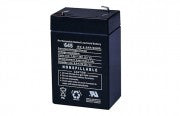
Emergency Light Batteries come in a variety of shapes and sizes. The 6 volt 4.5 amp sealed lead acid battery is one of the most common models found in emergency light fixtures. It is affordably priced and can ship today.
We carry all different shapes, sizes, and models of emergency light batteries and are happy to answer any related questions you might have. Call us today to place an order or to learn more about our battery selection. You can also email our battery specialists for information and to request a quote or invoice.
Without the right battery installed, emergency lights will not function correctly in a dangerous situation like a fire, earthquake or other scenarios when building AC power is lost. OSHA (Occupational Safety and Health Administration) guidelines require scheduled preventative maintenance to insure the units will work during a power outage.
EMERGENCY LIGHT BATTERIES:
- Power lamp heads during an emergency
- Must last for at least 90 minutes
- Affordable and easy to replace
- Available in different voltages and amperages
- Tested monthly and annually per OSHA regulations
Battery test buttons come standard on all emergency lights. By pressing the test button, the emergency light unit switches from AC power to emergency battery power, allowing you to clearly see the remaining charge.

A fully charged battery in good condition should power an emergency light for at least 90 minutes as mandated by UL (Underwriters Laboratories). If the battery cannot last for 90 minutes, it must be replaced. The UL 924 Listing is only featured on batteries that meet or exceed UL's rigorous testing procedures.
Many of today's emergency light fixtures come with a self-testing option that allows the unit to run monthly and yearly checks automatically, reducing the need for maintenance and improving the efficiency of a buildings emergency lighting system.
Replacing them is also a very important thing to know how to do...
SO WHEN SHOULD I REPLACE AN EMERGENCY LIGHT BATTERY?
Per OSHA guidelines emergency light owners should perform regular scheduled maintenance at monthly and annual intervals. If either the 90-second or 90-minute emergency readiness tests prove unsatisfactory (i.e. the lamps don't light up) replacing your emergency light batteries may be required.
Luckily the maintenance involved is actually very quick and simple, as most modern luminaries have a push-to-test switch that gives you an accurate battery reading. Pressing this test button activates the device's cutoff circuits (simulating a loss in AC electrical power) and should trip the battery. If the battery is dead, the lamps do not come on. It's really that simple.
REPLACING YOUR EMERGENCY LIGHT BATTERIES - STEP BY STEP
STEP 1 - Take a screwdriver and open up the housing. Most emergency lights will take a philips head head, though some hazardous location of vandal proof luminaire's will use a special hex driver bit. Hopefully you or your maintenance department kept the included bit when the device was purchased.
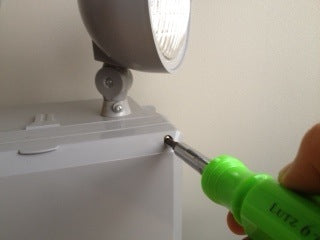
STEP 2 - Now that you have removed the plate you will be presented with lots of wires (don't worry its normal). Some of these red, black, blue or white electrical wires will lead from the AC electrical conduit to a voltage transfomer that leads to the switching circuits. One, two or several wires connect the circuit board to the battery.
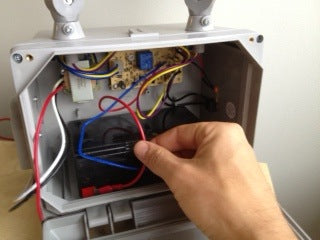
STEP 3 - Depending on you emergency light, the battery will either be a sealed lead acid (SLA) or Nickel Cadmium (NiCd) battery type. SLA's tend to look like baby car batteries, while NiCd usually resemble normal household AAA batteries, sealed in a protective plastic shrink wrap.
Most batteries will slide out of the unit once the leads have been removed from the + and - contact points. Some cells will be housed in a harness, which you must also remove.
IDENTIFYING THE RIGHT REPLACEMENT BATTERY
Remove the harness and battery from the housing. The first thing to note is the voltage which is typically 6v or 12v. Never try to use a 12V cell in a 6V emergency light, or vice-versa.
ONE OF THE QUICKEST WAY TO FIND THE BATTERY TYPE IS TO SIMPLY LOOK AT THE LABELS INSIDE THE HOUSING. ON THIS WET LOCATION EMERGENCY LIGHT, IT READS:
"REPLACE WITH JIMING TYPE: JM-6M10.0AC"
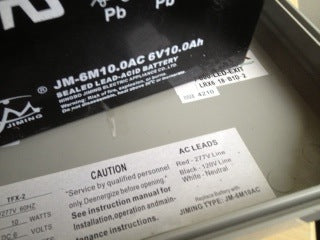
A quick Google search should tell you this is a battery manufactured by NingBo Jiming Electric Appliance Company. They likely have several US distributors around North America that you can readily purchase from. Simply place an order and the battery is at your door in two weeks. However, if no discernible battery type is specified, or if you wish to cross over to an American brand, call a certified distributor like Emergency Lights Co.
Before making the call, be sure to to identify your dead battery's voltage (6V or 12V), dimensions (Length x Width x Height in inches) and terminal type to source a new battery. But wait, you say, what the heck is a terminal type?
IDENTIFYING BATTERY TERMINAL TYPE
SEALED LEAD ACID (SLA)
Faston Tabs(pictured) are the most common terminal for this battery. Your luminaire will be supplied with a red, black and white blade connectors which slip over these tabs to close the circuit.
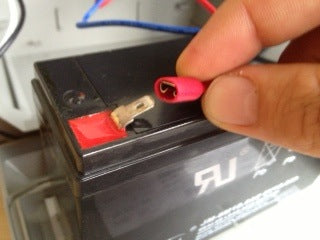
L terminals are found on some larger batteries. They have an L-shaped post with a bolt hole on the vertical side. These most resemble car battery terminals, so they are incredibly rare unless they are heavy duty types rated for extended emergency runtimes.
NICKEL CADMIUM (NICD)
Female-to-Male battery leads are easy snap-in bullet connectors that make wiring multiple NiCd cells quick and simple. Since each battery in the pack has its own positive and negative terminals, multiple cells are combined into one easy to connect lead.
TYPES OF EXIT SIGN BATTERIES
OVERVIEW
Most emergency Exit Signs are powered by a building's AC power which keeps the battery backup system fully charged. During a power failure the battery will need to light the sign for at least 90 minutes. But did you know Exit Signs use more than one type of battery? This article we will delve further into the types of batteries used in these life-saving signs.
VIEW OUR EXIT SIGN BATTERIES
Some Exit Signs on the market do not require power, however, they are often confused with our electric LED models. Such non-electric fixtures include Photoluminescent (glow in the dark) and Self-Luminous signs, which are naturally illuminated by a glowing hydrogen gas called tritium. Such battery-free units are perfect for remote locations where a building's electricity is not readily available and have a 20-year operational life; far longer than the 90 minutes provided by electrical units.
Long ago, Exit Signs were not even considered emergency fixtures, expiring the second a power loss occurred. Later, buildings began installing battery units on each floor to power a string of remote Exit Signs. While a major advance from the prior generation, these early emergency units suffered from an overloaded power-source that would drain to quickly after a power failure.
Today laws and technology have advanced considerably. The incandescent bulbs of the last century, which might last two years, have been phased out by LED technology that lasts a decade and uses a fraction of the wattage. Modern Exit Signs also have smaller batteries that fit within the unit. These combined advantages lead to a more efficient, longer lasting sign.
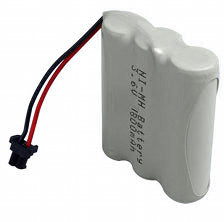
Nickel Cadmium (NiCad) emergency light batteries are popular for their compact size and powerful capacities. It is affordably priced and can ship today.
EXIT SIGN BATTERY TYPES
Only three types of battery cells are used in modern Exit Signs: nickel cadmium (NiCad), nickel metal hydride (NiMH) and sealed lead-acid. Nickel cadmium batteries can last up to ten years and come in various sizes and capacities to fit different requirements. They resemble small black bricks with contact points on the front and sides.
Nickel hydride cells appear to be the same as nickel cadmium batteries, only smaller. That is because the only major difference in NiMH design are its negative contact points, made of a hydrogen-absorbing allow rather than cadmium.
Sealed lead-acid batteries are found in most pre-LED exit technologies and current Exit Sign Combo units. Despite their age, sealed lead-acid can carry a heavier electric load than NiCad or NiMH, making them ideal for Combo units which include powerful dual headlamps on top of the standard LED exit design.
Knowing a little bit about battery requirements for the various emergency exit signs will make purchasing replacements much easier in the future.
CONCLUSION
Replacing your own batteries may sound like a job for the electrician or maintenance man. But as you see it is actually pretty simple stuff! It requires ZERO knowledge of electricity or wiring and does not require a certified electrician to install.
If you still have questions, give us a call at 800.480.0708.